
Collective self-consumption photovoltaics to supply the Paris-Saclay heating and cooling grid
Collective self-consumption photovoltaics to supply the Paris-Saclay heating and cooling grid
The heating and cooling grid of the Paris-Saclay science and technology cluster, delivered in 2019, is one of the pilot sites of the European D2Grids project. This so-called "fifth-generation" heating and cooling grid (5GDHC) should make it possible to meet many of the challenges of the energy transition: energy autonomy, consumption of renewable and local energy, grids decarbonation, etc. It covers an area of 28 municipalities in the south-west of the Île-de-France region.
Mawya Rahal, energy project manager at the EPA Paris-Saclay, and Lucas Lazzarini, energy engineer at SEQENS, answer relevant questions on the topic in the following interview.
The social housing company SEQENS recently joined D2Grids project to bring a collective self-consumption photovoltaic production, the part of which not consumed by its buildings will be sold to the grid. The buildings concerned will be connected to the Paris-Saclay heating and cooling grid by 2024.
Question: Can you present the Paris-Saclay heating and cooling grid?
Mawya Rahal: To fully understand this network, we need to look at the context of the operation. Indeed, it is part of the of Paris-Saclay urban planning, as a response to an Operation of National Interest (OIN). The objective is to develop the scientific and technological cluster of Paris-Saclay thanks to an urban ambitious strategy of sustainable development and social responsibility, supported by the EPA Paris-Saclay. This implies the implementation of an efficient and virtuous energy supply to meet the needs of existing buildings and those under construction.
We therefore wanted to set up the most virtuous system possible, based on renewable energies: the fifth generation for heating and cooling grids. This grid is based on a low-temperature energy loop, supplied with geothermal energy thanks to wells capturing the calories from the Albien Aquifer at a depth of 700m. It is supplemented by a gas back-up which takes over during peaks in consumption, particularly in winter. We are currently looking to develop other sources of renewable energy to avoid gas.
In 2016, we connected the first buildings on the Paris-Saclay plateau to the heating grid. In the long term, we want to connect about 2 million square meters of floor space, or 50 megawatts of heating and cooling capacity. Today, we have about 646,000 m² of connected housing, along with schools and public buildings.

